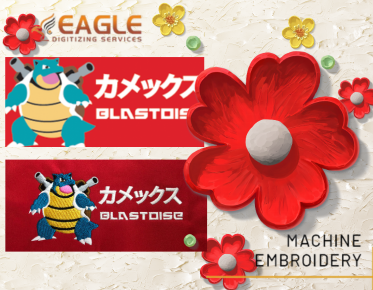Unlocking Creativity: A Comprehensive Guide to Getting Your Designs Digitized for Embroidery
Embroidery is an art form that has been cherished for centuries, with intricate designs adorning clothing, accessories, and home decor items. In today's digital age, the process of getting your designs digitized for embroidery has become more accessible and streamlined than ever before. Whether you're a seasoned embroiderer or a novice looking to explore the world of embroidery, understanding how to digitize your designs is essential for bringing your creative vision to life. In this comprehensive guide, we'll dive deep into the process of getting your designs digitized for embroidery, explore the advantages of using embroidery digitizing services, and provide practical tips for achieving professional results. By mastering the art of embroidery digitizing, you can unlock a world of creative possibilities and elevate your embroidery projects to new heights of excellence.
Understanding Embroidery Digitizing
Embroidery digitizing involves transforming artwork or designs into a digital format that embroidery machines can interpret and stitch. This digital file, known as a "digitized file" or "embroidery file," contains instructions for the machine to follow, dictating the placement, density, and sequence of stitches to recreate the design accurately on fabric. While some basic embroidery machines come pre-programmed with built-in designs, custom designs require specialized digitizing software and expertise to create.
Advantages of Using Embroidery Digitizing Services
1. Expertise and Experience:
One of the primary advantages of using embroidery digitizing services is access to expertise and experience. Professional digitizers have a deep understanding of embroidery techniques, software tools, and industry best practices, honed through years of hands-on experience in the field. They possess the skills and knowledge necessary to transform your designs into high-quality digitized files that are optimized for embroidery machines. By entrusting your digitizing needs to a reputable service provider, you can benefit from their expertise and ensure that your designs are digitized to the highest standards.
2. Time and Cost Savings:
Digitizing embroidery designs can be a time-consuming and labor-intensive process, especially for complex or intricate designs. By outsourcing digitizing tasks to a specialized service provider, you can save valuable time and resources that can be allocated to other aspects of your business. Additionally, outsourcing digitizing services can be more cost-effective than hiring an in-house digitizer, as you only pay for the services you need on a per-design basis. This allows you to control costs and maintain flexibility in your budget while still receiving top-quality digitized designs.
3. Customization and Personalization:
Embroidery digitizing services offer a high degree of customization and personalization, allowing you to tailor your digitized designs to suit your specific needs and preferences. Whether you're looking to replicate a logo or artwork with precision or add custom text and embellishments to your designs, a professional digitizer can bring your creative vision to life with unparalleled accuracy and attention to detail. By working closely with a digitizing service provider, you can collaborate to create custom designs that reflect your brand identity and stand out from the competition.
4. Access to Advanced Technology:
Embroidery digitizing services have access to advanced software tools and technology that enable them to produce high-quality digitized designs quickly and efficiently. These tools allow digitizers to manipulate and edit designs with precision, adjust stitch densities and patterns, and optimize designs for different types of fabric and embroidery machines. By leveraging the latest technology and software solutions, digitizing services can deliver superior results that meet or exceed your expectations, ensuring that your embroidered products look professional and polished.
5. Scalability and Flexibility:
Whether you're a small business owner or a large-scale manufacturer, embroidery digitizing services offer scalability and flexibility to accommodate your needs. Whether you require digitizing for a single design or bulk digitizing for a large batch of designs, a professional digitizer can handle projects of any size and complexity. Additionally, digitizing services can work with a wide range of file formats and design types, allowing you to digitize everything from simple logos to complex artwork and illustrations.
Practical Tips for Getting Your Designs Digitized
1. Choose the Right Design:
When preparing your designs for digitizing, it's essential to select or create designs that are suitable for embroidery. Choose designs that are clear, well-defined, and free from intricate details that may be challenging to replicate with embroidery stitches. Avoid designs with fine lines, small text, or complex gradients, as these may not translate well to embroidery. If you're unsure whether your design is suitable for embroidery, consult with a professional digitizer for guidance and recommendations.
2. Prepare Your Artwork:
Before submitting your designs for digitizing, take the time to prepare your artwork to ensure optimal results. Clean up any stray lines, stray pixels, or unnecessary elements from your design using graphic design software. Convert your artwork to vector format if possible, as vector files are ideal for embroidery digitizing and can be easily scaled to different sizes without loss of quality. Save your artwork in a high-resolution format such as EPS, AI, or PDF to preserve the integrity of your design during the digitizing process.
3. Select a Reputable Digitizing Service:
Once your artwork is prepared and saved in the appropriate file format, it's time to choose a reputable embroidery digitizing service to handle the digitization process. Look for a service provider with a proven track record of delivering high-quality results and excellent customer service, like Eagle Digitizing. Consider factors such as experience, expertise, turnaround time, pricing, and customer reviews when making your decision.
4. Communicate Clearly with Your Digitizer:
When working with a digitizing service provider, clear communication is key to ensuring that your designs are digitized to your satisfaction. Provide detailed instructions and specifications for your digitizing project, including information on stitch types, colors, and dimensions. Be open to feedback and suggestions from your digitizer, and don't hesitate to ask questions or seek clarification if you're unsure about any aspect of the digitizing process. By establishing clear lines of communication, you can ensure that your digitizer understands your vision and delivers results that exceed your expectations.
5. Review and Approve the Digitized Design:
Once your design has been digitized, take the time to review and approve the digitized file before proceeding with production. Evaluate the quality and accuracy of the digitized design, paying close attention to details such as stitch density, color placement, and overall appearance. Test the digitized design on different fabrics and embroidery machines to ensure that it produces the desired results. If necessary, request revisions or adjustments from your digitizer to address any issues or concerns before finalizing the design.
Conclusion
Embroidery digitizing is a crucial step in bringing your creative vision to life and creating stunning embroidered designs that capture attention and inspire admiration. By outsourcing digitization to a professional service like Eagle Digitizing, you can take advantage of expert craftsmanship, advanced technology, and personalized support to achieve the best possible results for your embroidery projects. With the advantages of professional quality, customization options, time and cost savings, access to advanced technology, and expert guidance and support, there's no better choice than Eagle Digitizing,for all your embroidery digitizing needs. So why wait? Get started on digitizing your designs today and unlock the full potential of embroidery for your business or creative endeavors.


.png)
